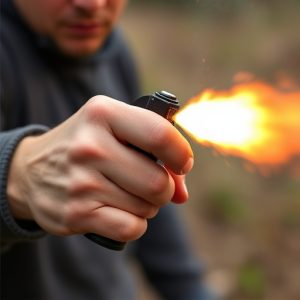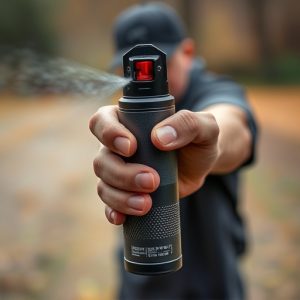OC Spray & Capsaicin: Understanding Concentration & Safe Use
OC Spray's effectiveness against assailants hinges on its capsaicin concentration levels, rangi…….
OC Spray's effectiveness against assailants hinges on its capsaicin concentration levels, ranging from 1.5% to 2%, with higher concentrations offering stronger protection but intensifying potential side effects. Law enforcement and personal users have differing needs, leading to varied capsaicin levels for subduing aggression or deterrence. Safety protocols include inspecting for damage, proper storage, aiming precisely at targets while protecting face and hands, wearing PPE, seeking fresh air after accidental discharge, and regular servicing to maintain effectiveness and prevent unauthorized access.
Personal protection sprays, especially those containing capsaicin—the active ingredient found in chili peppers—are gaining attention as inflammatory agent defenses. This article delves into the world of OC spray and capsacin concentration levels. We’ll explore how these factors impact the effectiveness of personal protection and discuss essential safety measures for responsible use. Understanding these aspects is crucial when considering an OC spray as a self-defense tool, ensuring its optimal performance in various situations.
- Understanding OC Spray and Its Active Ingredient: Capsaicin
- Factors Affecting Capsaicin Concentration in Personal Protection Sprays
- Safety Measures and Best Practices for Using Inflammatory Agent Sprays
Understanding OC Spray and Its Active Ingredient: Capsaicin
OC Spray, a popular choice for personal protection against aggressive individuals or in self-defence scenarios, is an aerosol that deploys a potent chemical agent to disable and deter assailants temporarily. The primary active ingredient in OC Spray is capsicin, a natural compound derived from chili peppers. Capsaicin irritates the eyes, nose, throat, and skin, leading to intense pain and discomfort, thus providing users with time to escape or call for help.
The effectiveness of OC Spray largely depends on its capsicin concentration levels. Typically, these levels are measured in percent by weight (e.g., 1.5% or 2%). Higher concentrations offer more robust protection but also increase the spray’s potential side effects. Understanding the OC Spray capsicin concentration is crucial for users to make informed decisions based on their specific needs and environmental considerations.
Factors Affecting Capsaicin Concentration in Personal Protection Sprays
The capsaicin concentration in personal protection sprays, often referred to as OC spray or pepper spray, is a critical factor in its effectiveness against potential threats. Several elements influence this concentration, ensuring that the spray delivers the right level of irritant for self-defense purposes. One of the primary factors is the intended use and target audience. For instance, law enforcement agencies may opt for higher capsaicin levels to subdue aggressive individuals, while personal defense sprays often have lower concentrations to deter initial attacks without causing permanent harm.
Another significant variable is regulatory compliance. Manufacturing standards and legal restrictions dictate the maximum capsaicin concentration allowed in these sprays. These regulations ensure consumer safety and prevent overuse of potent irritants. Additionally, environmental conditions can impact the spray’s effectiveness; temperature and humidity levels can affect the concentration’s delivery and potency over time, highlighting the need for proper storage and handling practices.
Safety Measures and Best Practices for Using Inflammatory Agent Sprays
Using inflammatory agent personal protection sprays, such as those containing capsaicin, requires strict adherence to safety measures and best practices. Always inspect the spray for any damage or defects before each use, ensuring the OC spray capsicum concentration levels remain within safe limits. It’s crucial to follow manufacturer instructions regarding range, aiming techniques, and activation procedures. Maintain a safe distance from individuals, especially in confined spaces, to prevent accidental exposure or cross-contamination.
When deploying the spray, aim for the target area while keeping your face and hands protected. Wear appropriate personal protective equipment, including gloves and eye protection, to minimize direct contact with the spray. In case of accidental discharge, immediately seek fresh air and wash affected areas with water. Regularly service and store the spray in a secure location, away from children and unauthorized individuals, to maintain its effectiveness and ensure safety at all times.
OC spray, primarily composed of capsaicin, offers a powerful tool for personal protection against potential threats. Understanding the factors influencing capsaicin concentration is key to maximizing its effectiveness. By adhering to safety measures and best practices, users can ensure the safe and efficient deployment of OC spray during critical situations. Remember, proper handling and knowledge of OC spray’s active ingredient are essential for self-defense and law enforcement applications alike, making it a valuable asset in maintaining safety at various levels.


